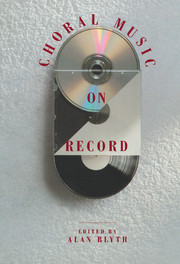Book contents
- Frontmatter
- Contents
- Preface
- Monteverdi: Vespers (1610)
- J.S. Bach: St John Passion
- J.S. Bach: St Matthew Passion
- J.S. Bach: Mass in B Minor
- Handel: Messiah
- Mozart: Requiem Mass
- Haydn: The Creation
- Haydn: The Seasons
- Beethoven: Missa Solemnis
- Mendelssohn: Elijah
- Rossini: Stabat mater Petite messe solennelle
- Berlioz: Grande Messe des Morts Te Deum L'Enfance du Christ
- Verdi: Requiem Mass
- Brahms: A German Requiem
- Fauré: Requiem
- Elgar: The Dream of Gerontius
- Walton: Belshazzar's Feast, Tippett: A Child of Our Time, Britten: War Requiem
- Stravinsky: The Wedding Symphony of Psalms
- Janáček: Glagolitic Mass
- Discographies
- Index
Haydn: The Seasons
Published online by Cambridge University Press: 02 December 2009
- Frontmatter
- Contents
- Preface
- Monteverdi: Vespers (1610)
- J.S. Bach: St John Passion
- J.S. Bach: St Matthew Passion
- J.S. Bach: Mass in B Minor
- Handel: Messiah
- Mozart: Requiem Mass
- Haydn: The Creation
- Haydn: The Seasons
- Beethoven: Missa Solemnis
- Mendelssohn: Elijah
- Rossini: Stabat mater Petite messe solennelle
- Berlioz: Grande Messe des Morts Te Deum L'Enfance du Christ
- Verdi: Requiem Mass
- Brahms: A German Requiem
- Fauré: Requiem
- Elgar: The Dream of Gerontius
- Walton: Belshazzar's Feast, Tippett: A Child of Our Time, Britten: War Requiem
- Stravinsky: The Wedding Symphony of Psalms
- Janáček: Glagolitic Mass
- Discographies
- Index
Summary
In the great concluding achievement of his career Haydn looks back and celebrates his love of nature and his deep sense of man's harmony with the natural world. As Robbins Landon remarks, The Seasons is a valedictory work; Haydn is ‘describing things – the first glow of dawn on the horizon, the hazy heat of midsummer, the ripe fields of autumn – which will soon retreat beyond his grasp’. Yet they are evoked with all his former energy and zest. Though Haydn complained that the task of setting Baron van Swieten's text exhausted him, there is little sign of it in the music. Age left its mark not on the freshness and vigour of his creativity but only on the character of the work, which culminates in the wonderful bass meditation on the brevity of human life, followed by the jubilant final chorus expressing the composer's sure faith in the eternal life to come.
It may be that Haydn would have liked van Swieten to have given him more opportunities for this sort of thing, as he had done in The Creation (on which the two men had collaborated a few years earlier), and less of what Haydn himself disparaged as ‘Frenchified trash’ – the musical imitation of frogs and other fauna and flora which he said was forced on him. Haydn also said that The Seasons was inferior to The Creation because it was about peasants whereas The Creation was about angels. But The Creation too has its roaring lion, its ‘flexible’ tiger and its crawling worm.
- Type
- Chapter
- Information
- Choral Music on Record , pp. 132 - 138Publisher: Cambridge University PressPrint publication year: 1991



